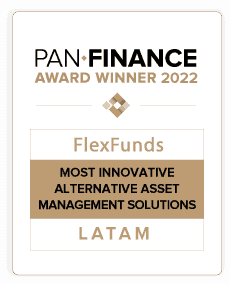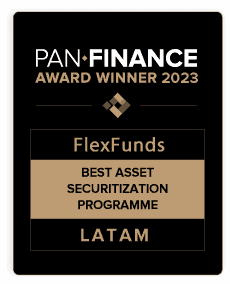- FIBRAs are financing structures that allow investors to access the real estate sector without the need to acquire properties directly.
- FIBRAs originate from the model of Real Estate Investment Trusts (REITs) in the United States.
- FlexFunds, by facilitating the distribution of real estate strategies, can offer developers and managers a way to diversify their investor base and simplify the distribution of real estate assets through their securitization.
FIBRAs are an investment vehicle that has traditionally been present in asset managers’ portfolios. These managers offer exposure to the real estate sector to a diversified group of investors and participation in projects of all kinds, FlexFunds explains.
Among the wide spectrum of investment vehicles, Real Estate Investment Trusts (REITs) are among the most recognized by asset managers.
FlexFunds enables developers, managers, and real estate investment funds to increase and simplify the distribution of their strategies, sharing five key aspects of this type of investment trust:
1. What are FIBRAs?
These are structured financing vehicles that offer direct exposure to the real estate sector. To achieve this, they pool funds from different investors to create a portfolio of real estate assets. They focus on financing both the acquisition and construction of high-quality real estate of all types, ranging from industrial warehouses to offices and shopping centers. Through their management, these real estate assets generate returns derived from their leasing or appreciation, which are distributed among the different investors in the form of dividends.
2. What is the origin of FIBRAs, and how are they regulated?
According to information from the Mexican Association of Real Estate Investment Trusts (Amefibra), in the 1960s, the United States became the first market to adopt the model of Real Estate Investment Trusts (REITs), which are the basis for FIBRAs. Both models may differ in the fact that REITs are standalone companies that trade on stock markets, while FIBRAs correspond to autonomously administered trusts.
Following the footsteps of the U.S., G7 countries also implemented their guidelines, and at least three Latin American countries, including Mexico, have followed suit. In 2021, this model expanded to China, demonstrating its global influence and adaptability to different economic and political contexts.
In Mexico, for example, the financial entity BBVA explains that FIBRAs have been listed on the Mexican Stock Exchange (BMV)1 since 2011. Generally, these are supervised by stock market authorities, which in the Mexican case are the National Banking and Securities Commission (CNBV) and the Mexican Stock Exchange (BMV).
The constitution of FIBRAs implies that they have 70% of their assets invested in real estate intended for leasing and must also distribute among the holders of the Bourse Certificates (CB) -participations in the instrument- 95% of the value equivalent to the result of the immediately previous fiscal year, according to BBVA.
Currently, other countries are evaluating the possibility of implementing this model, recognizing its potential to strengthen their respective real estate and economic sectors in general, according to Amefibra.
FIBRAs allow investors of various sorts to access the real estate market without the need to manage assets directly.
3. Who can invest in real estate FIBRAs?
Unlike other instruments, FIBRAs are characterized especially because they allow direct exposure to the real estate sector without the need for participants to acquire these assets on their own. This means that more participants can start to become involved in real estate investments, and this vehicle is not limited only to large capital that can acquire these high-quality assets.
As investors, these individuals acquire stakes in these projects and do not have to deal with their management. In simple terms, anyone can access FIBRAs and start buying the securities through a broker. However, there are also associated risks like any other type of investment.
FlexFunds, through its programs like the Flex Private Program, can provide an efficient and scalable platform for asset managers to securitize their real estate projects, which can allow them to expand the base of potential investors and promote diversification.
FlexFunds positions itself as a key facilitator in the FIBRA market by offering solutions for the distribution of real estate assets, through its asset securitization program, facilitating access to international investors.
4. How do real estate FIBRAs operate?
When a real estate owner requires financing, they turn to one of these investment trusts, which grants them titles called Ordinary Participation Certificates (CPO) that represent a stake in the assets.
The trust then issues these titles on the stock exchange as Shares or Bourse Certificates (CB), which investors access in exchange for the returns these assets provide through leasing or appreciation. With these resources, the owner of these assets can execute planned projects and progress with their plans, generating the returns that investors require.
Through its programs, FlexFunds offers developers, managers, and real estate investment funds the opportunity to improve and expedite the distribution of their strategies by accessing international investors efficiently and scalably through asset securitization.
The Flex Private Program offers various options to improve the management and distribution of real estate projects, ranging from creating their own exclusive Irish special purpose vehicle to investment instruments, both equity and debt, through a title listed on Euroclear.
FlexFunds can play a relevant role in this expansion by offering investment vehicles with which to repack real estate asset, and facilitate distribution .
5. Aspects to consider in FIBRAs
On the one hand, it should be considered that this is a hybrid instrument, as it has elements of both equity and fixed income. Different financial analysts point out that this type of instrument provides diversification to investment portfolios while also providing regular income. Additionally, since resources and assets are managed by professionals, investors do not have to worry about the operational aspects involved in managing real estate assets.
However, on the other hand, fluctuations in the real estate sector should also be considered, as they can impact the instrument’s performance. In the current situation, for example, high global interest rates can influence investments in this field.
Likewise, it should be taken into account that there are stages where income may be reduced due to natural circumstances such as property vacancies. In any case, it is crucial to understand the conditions and risks associated with this instrument before making any financial decisions.
Considering this context, FlexFunds becomes a strategic ally in the distribution of real estate assets, providing accessibility through securitization, which serves as a bridge to reach multiple private banking platforms. These strategies facilitate the process of converting underlying assets into bankable assets.
If you want to securitize your real estate investment fund, you can contact FlexFunds experts to take full advantage of the opportunities offered by FIBRAs through professional advice and an agile, simple, and cost-efficient solution.
Sources:
1https://www.bbva.com/es/inversiones-a-fondo-fibras-que-son-y-quienes-pueden-invertir/







